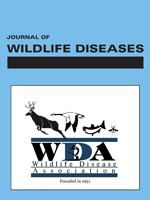Between August 1993 and September 1995, 24 gopher tortoises (Gopherus polyphemus) were received for pathological evaluations from various locations in Florida (USA). All tortoises were examined for clinical signs of upper respiratory tract disease (URTD) including nasal and ocular discharge, palpebral edema, and conjunctivitis. Of the 24 tortoises, 10 had current or previously observed clinical signs of URTD and 14 did not. A blood sample was drawn for detection of anti-mycoplasma antibodies by ELISA, and nasal lavage samples were collected for culture and detection of Mycoplasma agassizii gene sequences by polymerase chain reaction (PCR). Of the 14 clinically healthy tortoises, eight were sero-, culture- and PCR-negative, and six were seropositive for antibodies against M. agassizii. Of those six, five were culture- and/or PCR-positive for M. agassizii, and one was culture- and PCR-negative. Of the 10 ill tortoises, nine were seropositive by the ELISA and one was in the suspect range. Nine of the ill tortoises, including the suspect tortoise, were culture- and/or PCR-positive for M. agassizii, and one was culture- and PCR-negative. For histologic evaluation and discussion, the eight sero-, culture-, and PCR-negative tortoises were designated URTD-negative, and the other 16 were classified as URTD-positive. Histologic evaluation of the upper respiratory tract (URT) indicated the presence of mild to severe inflammatory, hyperplastic, or dysplastic changes in 14 URTD-positive tortoises. Seven of eight URTD-negative tortoises had normal appearing nasal cavities; one had mild in-flammatory changes. Transmission electron microscopy revealed an organism consistent with Mycoplasma spp. on the nasal mucosal surface of tortoises with clinical signs and lesions of URTD. Additionally, Gram-negative bacteria were isolated more frequently from the nasal cavities of URTD-positive tortoises than URTD-negative tortoises. Because clinical signs of URTD were never observed in six of the URTD-positive tortoises, we also conclude that subclinical URTD can occur in gopher tortoises.
How to translate text using browser tools
1 April 2000
PATHOLOGY OF UPPER RESPIRATORY TRACT DISEASE OF GOPHER TORTOISES IN FLORIDA
G. S. McLaughlin,
E. R. Jacobson,
D. R. Brown,
C. E. McKenna,
I. M. Schumacher,
H. P. Adams,
M. B. Brown,
P. A. Klein

Journal of Wildlife Diseases
Vol. 36 • No. 2
April 2000
Vol. 36 • No. 2
April 2000
gopher tortoise
Gopherus polyphemus
Mycoplasma agassizii
pathology
upper respiratory tract disease




